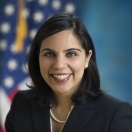
America’s progress in science and technology has countless revolutionary discoveries within our reach... New breakthroughs in treating cancer and ending the wait for organ transplants… That’s some of what America can do.President Obama, May 19, 2016
PATIENT STORIES | COMMITMENTS | ENGAGE
Why We Must Reduce the Organ Waiting List
There are currently more than 120,000 people on the waiting list for an organ in the United States. Every 10 minutes, someone is added to the national waiting list for a life-saving organ transplant. This is despite advances in clinical science and medical innovation over the last decade and widespread recognition by Americans that organ donation and transplantation make a real difference in people’s lives. Twenty-two people die every day in the United States while waiting for a life-saving transplant.
We must and can do more.
The good news is that reducing the organ waiting list is a problem that can be solved – and that’s why today, the Obama Administration and dozens of companies, foundations, universities, hospitals, and patient advocacy organizations are taking steps to change that by announcing a new set of actions that will build on the Administration’s efforts to improve outcomes for individuals waiting for organ transplants and support for living donors.
The actions being announced today aim to:
- Close the gap between the 95 percent of Americans who support organ donation and the roughly 50 perecent who are registered
- Invest in clinical research and innovation that could potentially increase the number of transplants by almost 2,000 each year and improve outcomes for patients
- Facilitate breakthrough research and development with almost $200 million in investments
Watch today's event live
Patient Stories
Last year, the United States exceeded 30,000 annual organ transplants for the first time. While much work remains to help the more than 120,000 Americans on the organ waiting list, progress is happening and great promise exists for the future.
For most Americans, getting off the organ waiting list and into the operating room for their life-saving transplant is a game-changing moment. When a transplantation goes well, it truly is a renewal on life – transplants have the hope of offering increased survival and more quality time spent with family and friends. Here is a spotlight on some patients who were fortunate enough to get a life-saving transplant and are doing well:
A letter from NBA Champion Alonzo Mourning about his kidney transplant
Letters to President Obama about two patients who received organ transplants
Commitments to Reduce the Organ Waiting List
The Federal government along with dozens of companies, foundations, universities, hospitals, and patient advocacy organizations are stepping up to solve the problem of reducing the organ waiting list. Below are just a few of those commitments -- see the full list here.
Facilitating breakthrough research and development with almost $200 million in investments
Just a few generations ago, living without kidneys was unimaginable. But that diagnosis changed thanks to Dr. Willem Kolff, a Dutch immigrant who brought his invention of the dialysis machine to the United States after World War II. New breakthroughs in bioengineering, transplantation, and organ preservation can further increase the number of organ transplants and improve outcomes. Researchers have the potential to repair or replace tissues and organs, reduce waitlists for organ transplants, and potentially reduce health care cost for treatments – but we must continue to invest in breakthrough research and development. For example, consider that most organs can only be stored for three to twelve hours, which means that many viable transplant organs are discarded. If even half of all unused donated hearts and lungs could reach transplant patients in time, experts estimate that the waiting list for hearts and lungs could end in two to three years. Announcements include, among others:
- The Department of Defense (DOD) is announcing more than $160 million in public-private investment in a new Advanced Tissue Biofabrication Manufacturing Innovation Institute to research and develop next-generation manufacturing techniques that can be used to repair and replace cells and tissues and that may one day lead to organ replacement. DOD also is announcing $7 million in awards to small businesses working to advance the science and technology of organ and tissue preservation.
- The American Society of Nephrology (ASN) commits the first $7 million toward the design, launch, and execution of a potential Kidney Disease XPRIZE, in partnership with the XPRIZE Foundation.
- The Cystic Fibrosis Foundation (CFF) is announcing $15 million for projects dedicated to improving outcomes after lung transplantation.
- The Laura and John Arnold Foundation (LJAF) is announcing a $4.2 million grant to test donor interventions that maximize the quantity and quality of life-saving organs that each donor is able to give.
Closing the gap between the 95 percent of Americans who support organ donation and the roughly 50 percent who are registered organ donors
The donor registration system was first built in 1968 and has been run almost exclusively through states’ Departments of Motor Vehicles. Despite data showing 95% of Americans support organ donation, only approximately half are registered as organ donors. Now, with new technologies available, there is an opportunity to re-imagine the donor registration system in more seamless and effective ways, with the goals of increasing registrations and life-saving transplants. Today, more than 20 entities—from organ procurement organizations (OPOs) to patient advocacy organizations to major technology companies—have committed to help reduce the agonizing wait for an organ transplant. Announcements include, among others:
- More than 12 organizations including Facebook, ORGANIZE, Tinder, and Twitter are developing new tools and public advocacy campaigns to increase the options and ease of registering to be an organ donor, with a goal of achieving 1 million new registrations and social declarations by the autumn of 2016.
- Amy Poehler's Smart Girls will create content and use its social channels to promote organ donation and registration throughout summer and autumn of 2016.
Investing in clinical research and innovation that could potentially increase the number of transplants by almost 2,000 each year and improve outcomes for patients
Federal agencies are taking new actions to improve outcomes in transplantation, by improving support for veterans–who experience kidney failure at a higher rate than the general public–and helping more Americans access life-saving transplants through kidney paired donation, which pools living donors and recipients to increase the likelihood of matches. Private sector organizations are developing better resources and tools that are critical to ensuring access to life-saving transplantation opportunities. Announcements include, among others:
- Walter Reed National Military Medical Center (Walter Reed Bethesda) today announces a pilot to pioneer kidney paired donation chains started via the military share program–in which families of active duty military service members donate one of their kidneys to patients listed for transplant at Walter Reed–to help those who are hard to match to receive kidney transplants.
- More than 30 transplant centers are today announcing a collaboration to share data and best practices for kidney transplants for hard-to-match patients, which has the potential to help almost 1,000 more people a year access transplants.
- Johns Hopkins University is working with the National Institute of Allergy and Infectious Disease to launch a multicenter study of HIV-positive to HIV-positive organ transplants; as protocols are developed to use the HIV-positive donor pool, this could lead to as many as 1,000 more transplants per year.
- The United Network for Organ Sharing (UNOS), the nation’s Organ Procurement and Transplant Network, will increase efficiencies in the organ procurement and transplant system as well as the potential number of transplants through new technology and data tools that are open to transplant centers and the research community.
How You Can Engage
As the President highlighted in a Proclamation during National Donate Life Month earlier this year,
“We must all do our part to lift up donors, donor families, and patients by supporting efforts to shorten the organ waiting list. Together, we can improve and save lives by celebrating those who give of themselves –whether as living donors or registered donors – to provide the greatest gift there is to offer.”
We can all register today as an organ donor. Learn more now at either:
You can also support the President’s announcement on social media by using the hashtag #OrganDonor or using an organ donor frame on your profile pictures.
Robbie Barbero is the Assistant Director for Biological Innovation in the White House Office of Science and Technology Policy.
Jennifer Erickson is the Assistant Director for Innovation and Economic Growth in the White House Office of Science and Technology Policy.





